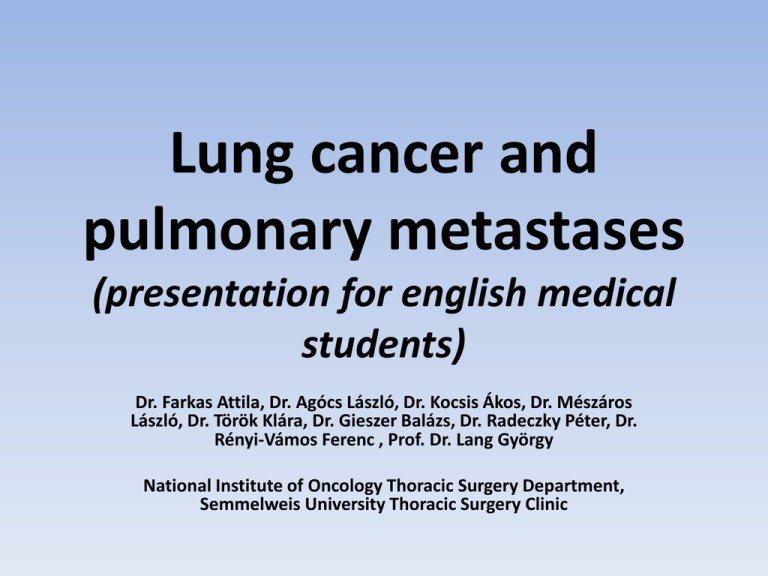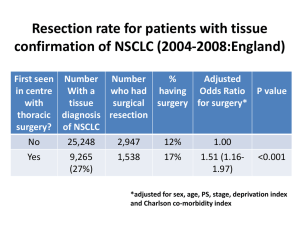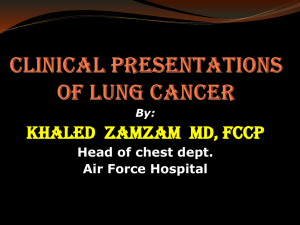Tüd* primer- és áttéti daganatai (oktatási prezentáció V. éves
advertisement

Lung cancer and pulmonary metastases (presentation for english medical students) Dr. Farkas Attila, Dr. Agócs László, Dr. Kocsis Ákos, Dr. Mészáros László, Dr. Török Klára, Dr. Gieszer Balázs, Dr. Radeczky Péter, Dr. Rényi-Vámos Ferenc , Prof. Dr. Lang György National Institute of Oncology Thoracic Surgery Department, Semmelweis University Thoracic Surgery Clinic I. case • What kind of diseases cause haemoptysis? A, oropharingeal origin/ distinguish hematemesis B, pulmonary origin C, cardiovascular origin (high blood pressure, mitral stenosis) D, haemostatic disorder Pulmonary origins of haemoptysis • Chronic inflammation (brochiectasis, TBC, lung abcess, pneumonia with necrosis) • Malignant and benign tumours • Malformations (AV malformations, bronchial telangiectasia) • Systemic diseases pulmonary manifestation (vasculitis, haemostatic disorder) • Others (pulmonary embolism, foreign body aspiration, iatrogenic, trauma) Lung cancer symptoms 1. Incidentally diagnostised without any kind of symptoms(5-15%) 2. Symptoms: - cough (40-70%) - dyspnea (50-70%) - weight loss (30-60%) - hemoptysis (20-40%) - chest pain (30-40%) - atelectasis, pneumonia (20%) Lung cancer syndromes Paraneoplastic syndromes: • Hematological: Trousseau syndrome (deep venosus thrombosis+thrombophlebitis migrans), anaemia • Endocrinological: Cushing-syndrome, SIADH, hypercalcaemia • Neurological: peripheral neuropathy, myasthenia gravis ( Lambert-Eaton syndrome) • Musculosceletal: hypertropic osteoarthropathia, clubbing of the digits • Other: fewer, acanthosis nigricans, retinopathy Lung cancer symptoms Other symptoms: • hoarseness (n. recurrens involved) • diaphragma paralysis (n.phrenicus involved) • dysphagy (oesophagus involved) • pleural effusion (carcinosis pleurae) • pericardial effusion (pericardium involved) • v .cava superior syndrome (v. cava superior involved) • Pancoast tumor: Horner triad, chronic shoulder pain II. case • What kind of tests would you choose in connection with lung cancer and why? • Chest CT ( morfology, localization, operability, lymp node involvment) • Bronchoscopy (morfology, localization, operability, lymp node involvment, biopsy) Hystology Benign tumors • Epithelial tumours: adenoma, papilloma • Dysontogenetic tumours: hamartoma, teratoma • Neurogenic tumours: neurinoma, neurofibroma • Mesodermal tumours: fibroma, lipoma, chondroma Hystology Malignant Non small cell lung cancer (NSCLC) • Adenocarcinoma (~40%) • Squamosus cell carcinoma (~25%) • Large cell carcinoma (~10%) • Carcinoid tumours(~10%) • Others: sarcomatoid, salivary gland tumours, not specified (~<1%) Small cell lung cancer (SCLC) (~15%) TNM staging (NSCLC) TNM staging (NSCLC) TNM staging (NSCLC) Stages (NSCLC) Staging (SCLC) • TNM system is used! But: • Limited disease: Disease restricted to one hemithorax with/without metastases in ipsior contralateral regional lymph node; or ipsilateral pleural effusion • Extensive disease: distant metastasis occurs outside the hemithorax Treatment Benigns tumours • surgical resection (atypical surgical resection: wedge or enucleation) is sufficient • sometimes anatomical resection needs • why operate?: because of the tumour can cause symptoms in the future and for the appropiate hystology Treatment Benign laesions- wedge resection Treatment NSCLC: • I-II/B stages operation (anatomical resection = lobectomy, bilobectomy, pulmonectomy+ lymphadenectomy) then if it’s needed chemoradiotherapy • III/A stage: neoadjuvant chemotherapy. Then restaging and if there is regression in the lymph nodes, operation (anatomical resection + lymphadenectomy ) then chemotherapy • III/B stage: Chemoradiotherapy • IV stage: Chemoradiotherapy. Rarely if there is isolated adrenal gland-,or intracranial- or liver metastases and there is a chance for the curative resection of the lung cancer it’s possible to remove the metastases and the lung cancer as well. Treatment SCLC: • Treatment is generally chemoradiotherapy ! • Rarely surgical procedure, only in case of „very limited disease” (T1N0, T2N0) • Before the operation, patients with negative N2 region in the chest CT should undergo diagnostic mediastinoscopy (exclude N2 cancer involvment) Treatment Malignant tumours-anatomical resection • Why anatomical resection? : decreasing local tumour recurrence Segmentectomy Lobectomy Pulmonectomy Treatment Open surgical procedures (thoracotomy) • Posteolateralis or anterolateralis thoracotomy 1. picture: posteolateral thoracotomy 2. picture anterolateral thoracotomy Treatment Video assistated thoracoscopy (VATS) • Atypical or anatomical resection as well! Obligated tests before lung resection • Laboratory tests (blood count, coagulogram, liver and kidney function, CRP, blood type and antibody) • Chest CT (or PET-CT) • Bronchoscopy • Lung function test • Arterial astrup test • In case of pulmonectomy lungscintigraphy • Head CT • Abdominal ultrasound • Consultations (most frequently with cardiologist) Lung metastases • Lung metastases are not equal with palliative chemoradiotherapy!!!! • If the primary tumour is under control and there is no metastases in other organs, or the other organs metastases are controlled by surgery , and if there is a chance for complete resection, they could surgically removed • No limit of number • Mainly colorectal, renal, non seminomatosus germ cell tumours, and sarcomas Lung metastases • Always atipical „lung saving” resections -wedge resection -laeser metastasectomy Thank you for your attention!











